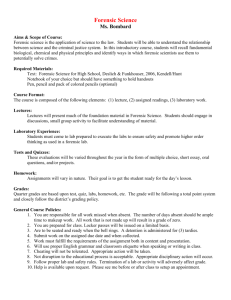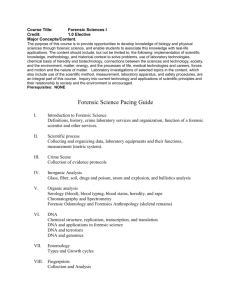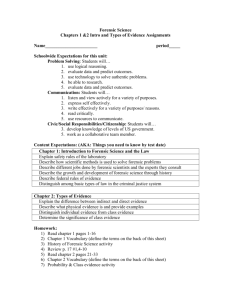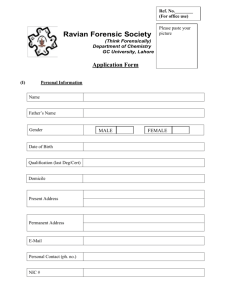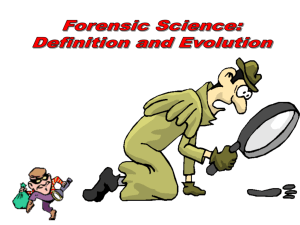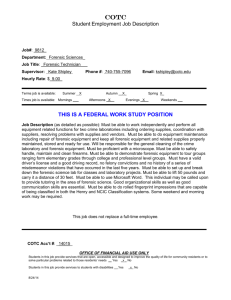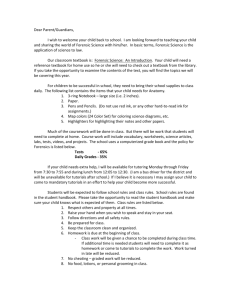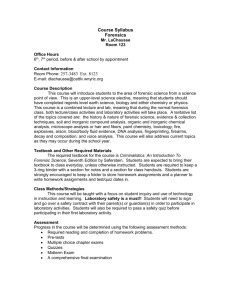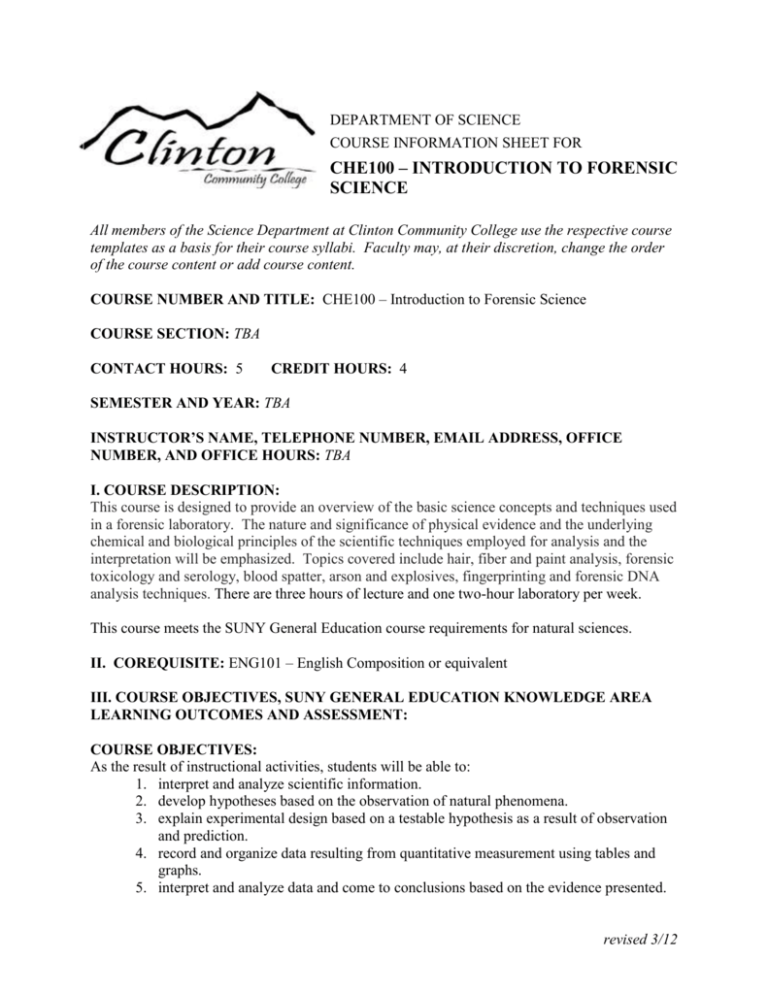
DEPARTMENT OF SCIENCE
COURSE INFORMATION SHEET FOR
CHE100 – INTRODUCTION TO FORENSIC
SCIENCE
All members of the Science Department at Clinton Community College use the respective course
templates as a basis for their course syllabi. Faculty may, at their discretion, change the order
of the course content or add course content.
COURSE NUMBER AND TITLE: CHE100 – Introduction to Forensic Science
COURSE SECTION: TBA
CONTACT HOURS: 5
CREDIT HOURS: 4
SEMESTER AND YEAR: TBA
INSTRUCTOR’S NAME, TELEPHONE NUMBER, EMAIL ADDRESS, OFFICE
NUMBER, AND OFFICE HOURS: TBA
I. COURSE DESCRIPTION:
This course is designed to provide an overview of the basic science concepts and techniques used
in a forensic laboratory. The nature and significance of physical evidence and the underlying
chemical and biological principles of the scientific techniques employed for analysis and the
interpretation will be emphasized. Topics covered include hair, fiber and paint analysis, forensic
toxicology and serology, blood spatter, arson and explosives, fingerprinting and forensic DNA
analysis techniques. There are three hours of lecture and one two-hour laboratory per week.
This course meets the SUNY General Education course requirements for natural sciences.
II. COREQUISITE: ENG101 – English Composition or equivalent
III. COURSE OBJECTIVES, SUNY GENERAL EDUCATION KNOWLEDGE AREA
LEARNING OUTCOMES AND ASSESSMENT:
COURSE OBJECTIVES:
As the result of instructional activities, students will be able to:
1. interpret and analyze scientific information.
2. develop hypotheses based on the observation of natural phenomena.
3. explain experimental design based on a testable hypothesis as a result of observation
and prediction.
4. record and organize data resulting from quantitative measurement using tables and
graphs.
5. interpret and analyze data and come to conclusions based on the evidence presented.
revised 3/12
6. calculate an initial unit of measurement to another unit using conversion factors from
the unit of an equality.
7. describe the characteristics of an element using the periodic table and the combination
of elements to form simple compounds.
8. describe several basic analytical techniques for the identification of organic and
inorganic substances.
9. describe the optical principles of different microscopes and their application in
examining various types of forensic evidence.
10. describe the characteristics of hair, fibers and paint and the different techniques used
in a forensic examination to determine a probability match.
11. describe and give examples of the different classes of drugs and their physiological
and psychological effects in humans as they relate to drug dependence.
12. describe the characteristics of alcohol toxicity and its detection in the breath and
blood using forensic analysis tools.
13. describe the forensic aspects of arson and explosion investigations.
14. describe the forensic serology techniques used to characterize and individualize
biological evidence.
15. describe the DNA typing techniques used to link with certainty the origin of
biological evidence to a single individual.
16. describe the fundamental principles of fingerprints and the techniques used for
detection and classification in the forensics laboratory.
LABORATORY OBJECTIVES:
The laboratory experience will reinforce scientific concepts and laboratory skills. Students will
demonstrate ability to:
1. Record, organize, graph and perform computations upon the data collected in the
laboratory.
2. Prepare a written laboratory report that effectively interprets and communicates their
results.
3. Effectively use computers as a tool for communication, data collection, data analysis.
4. Perform laboratory activities where students collect, organize and analyze data
demonstrating concepts from the major objectives listed above.
5. Demonstrate an understanding of operating and using a variety of techniques and
instrumentation used in a forensic laboratory setting including:
Fingerprinting techniques and methodologies
Various Chromatographic methods
Horizontal Gel Electrophoresis
Compound Microscopes
Spectrophotometers
LAB ACTIVITIES:
A complete list of proposed laboratory activities must be submitted with the course syllabus.
revised 3/12
SUNY GENERAL EDUCATION KNOWLEDGE AREA LEARNING OUTCOMES:
Students will demonstrate the ability to:
1. understand the methods scientists use to explore natural phenomena, including:
observation
hypothesis development
measurement and data collection
experimentation
evaluation of evidence
employment of mathematical analysis
2. apply scientific data, concepts and models in one of the natural sciences
IV. REQUIRED TEXTBOOK AND MATERIALS:
REQUIRED TEXTBOOK:
Criminalistics: An Introduction to Forensic Science, 10th edition; Richard Saferstein.
Pearson/Prentice Hall.
ISBN # 0-13-504520-7
REQUIRED MATERIALS:
1. Safety glasses are required for all on-campus sections.
2. Composition notebook is required for laboratory classes.
V. METHODS OF INSTRUCTION/COURSE ORGANIZATION: To be determined by the
respective instructor.
VI. ATTENDANCE PROCEDURE (INCLUDING MAKEUP POLICY): To be determined
by the respective instructor.
VII. BIBLIOGRAPHY OF READINGS (IF APPLICABLE): To be determined by the
respective instructor.
VIII. METHODS OF EVALUATION (INCLUDING THE CALCULATION OF COURSE
GRADE): To be determined by the respective instructor. The methods of evaluation shall
include tests (test types, length and weight of each), papers (weight of each), projects (weight of
each), and other forms of evaluation (weight of each).
IX. GRADING SCALE: To be determined by the respective instructor. The grading scale shall
indicate what numerical scores correspond to the following grades: A, A-, B+, B, B-, C+, C, C-,
D+, D, and F.
Please Include: If you have, or suspect you may have, any type of disability or learning problem
that may require extra assistance or special accommodations please speak to me privately after
class or during my office hours as soon as possible so I can help you obtain any assistance you
revised 3/12
may need to successfully complete this course. You should also contact Laurie Bethka, Room
420M in the Academic Assistance Center, for further assistance.
X. GENERAL TOPICS OUTLINE:
1. The Crime Scene
2. Physical Evidence
3. Physical Properties: Glass and Soil
4. Organic Analysis
5. Inorganic Analysis
6. The Microscope
7. Hairs, Fibers and Paint
8. Drugs
9. Forensic Toxicology
10. Forensic Aspects of Arson and Explosion Investigations
11. Forensic Serology and Bloodstain Pattern Analysis
12. DNA: The Indispensible Forensic Science Tool
13. Fingerprints
14. Firearms, Tool Marks, and Other Impressions
XI. ACADEMIC INTEGRITY: Academic honesty is expected of all Clinton Community
College students. It is academically dishonest, for example, to misrepresent another person’s
work as one’s own, to take credit for someone else’s work or ideas, to accept help on a test, to
obtain advanced information on confidential test materials, or to intentionally harm another
student’s chances for academic success.
XII. COURSE CONTINUITY PLAN:
In the case that the college officially closes because of an emergency which causes a short term disruption
of this course, we will utilize e-mail to continue this course in the short term (1-3 weeks). All students
need to utilize their campus e-mail to receive course related information.
XIII. TECHNOLOGY STATEMENT: A CCC student should expect that any class may
require some course activity that uses a computer and the internet. Activities could include but
are not limited to accessing the course syllabus, schedule, or other handouts on a website,
completing homework online, taking quizzes or submitting written work, participating in a
discussion or sending/receiving email.
revised 3/12

